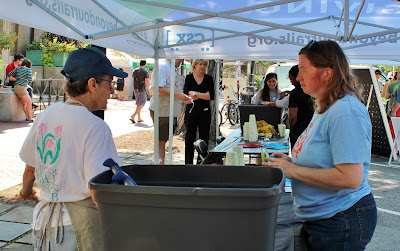 |
| Bill and David potting daffodils. |
September 22, 2013: A number of Club members were right in the heart of this year’s Barracks Row Festival, helping attendees to pot bulbs at the CSX Booth. This community festival on 8th Street SE had something for everyone, including the DC State Fair.
 |
| Sonia giving bulb planting instructions |
Families, singles, couples and lots of children were drawn to the booth where they potted a tulip or daffodil for planting later in the community and one for themselves to plant at home. For many festival participants it was their first exposure to bulbs and gardening; for others it renewed desires to garden.
 |
| Mary brings David up to date. |
Sporting their Garden Club aprons and armed with Club literature and brochures our volunteers won lots of smiles as they assisted and answered questions about bulbs. Many thanks to Club members Sonia Conly, Mary Weirich, David Healy, Bill Dean, Faith Brightbill, Mary Ann Sroufe, Sandra Bruce, Gene Smith, and Sharon Calkins-Hubley for lending their expertise and rolling out the welcome mat for those interested in learning more about our Club.
--Ida May Mantel



